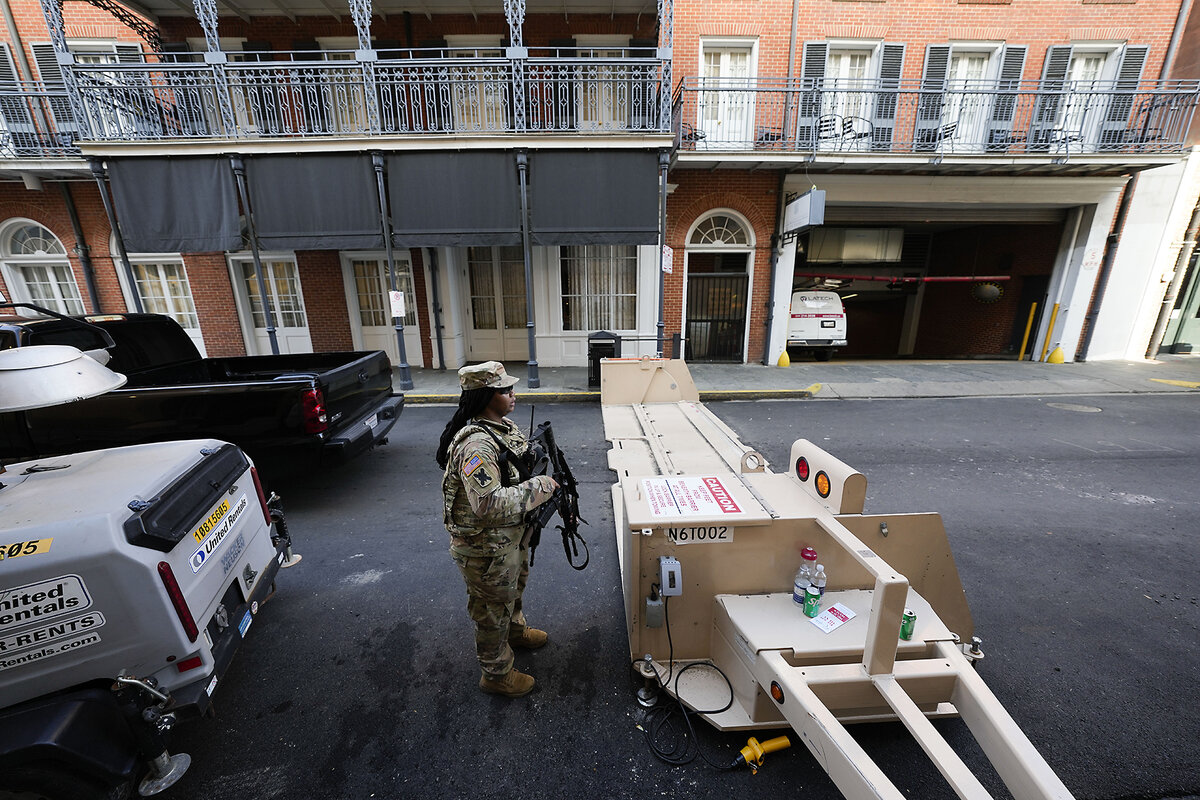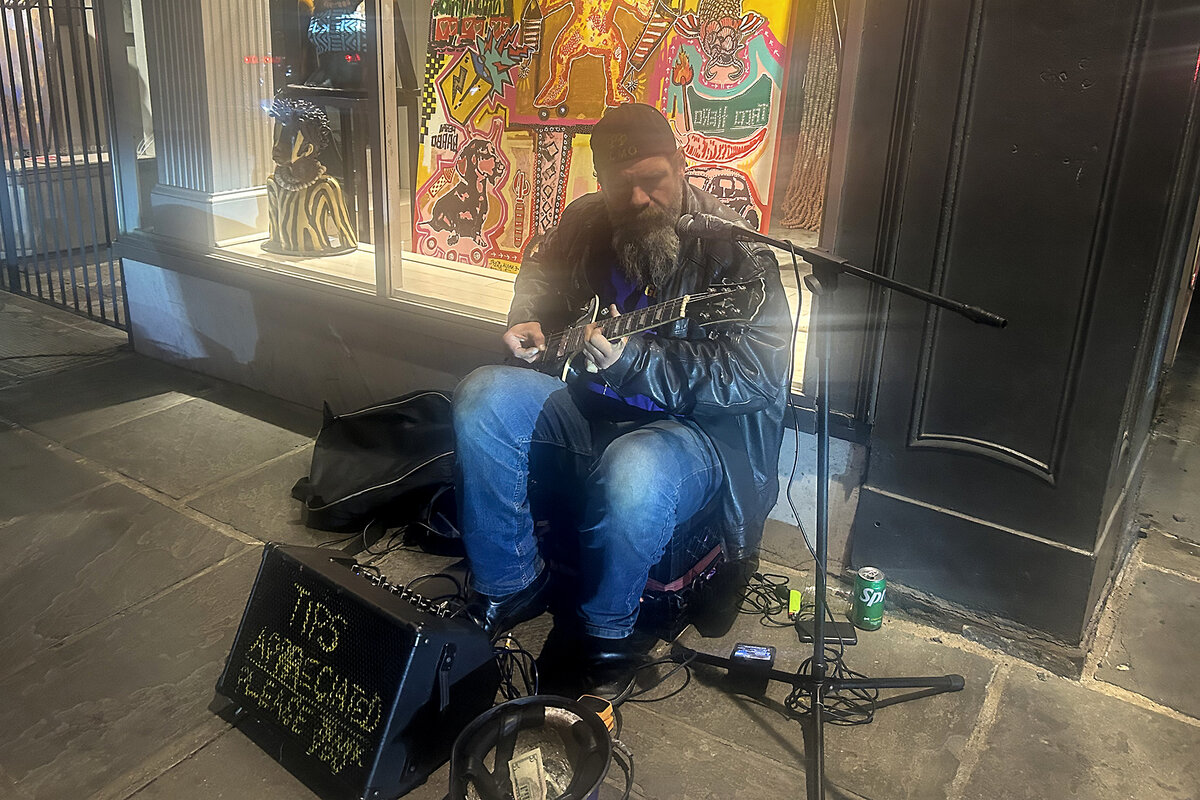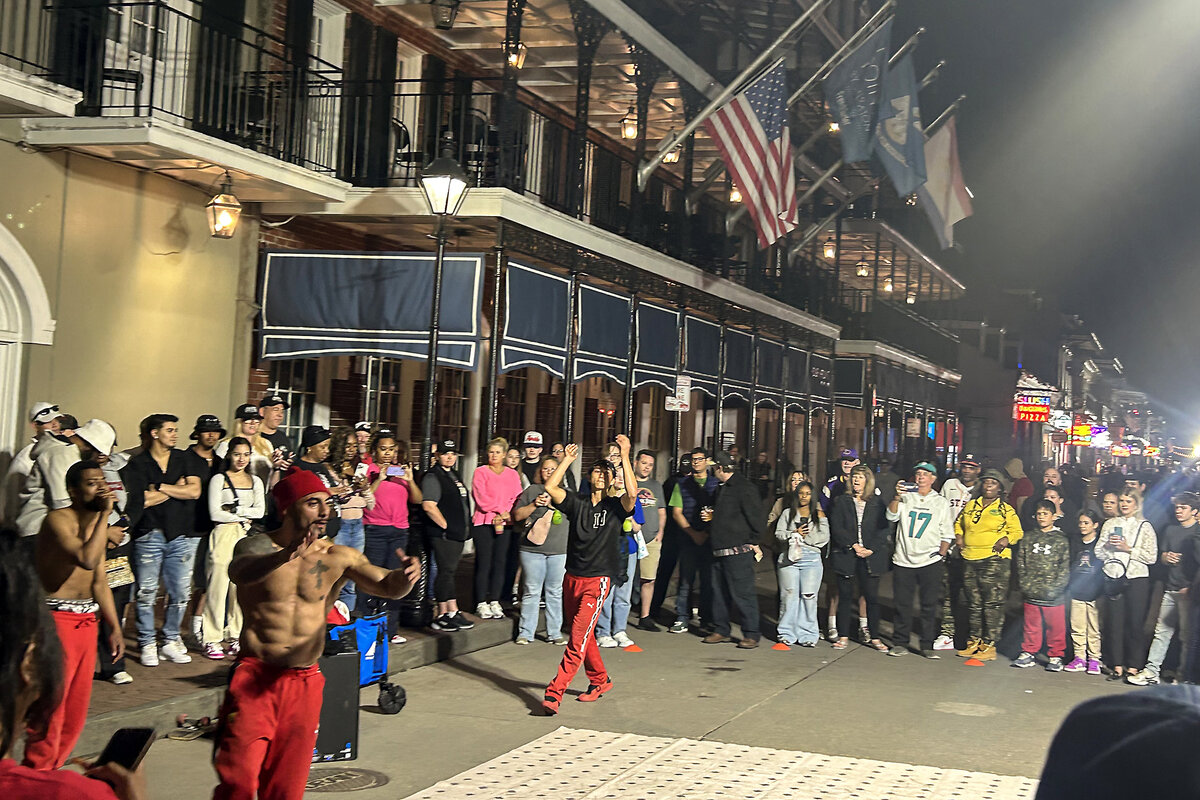New Orleans one month after terror attack: Bring on the Super Bowl
Loading...
| New Orleans
An estimated 125,000 visitors are touching down in New Orleans this week for the Super Bowl between the Kansas City Chiefs and the Philadelphia Eagles. And the street revelry is already palpable.
The city where you can eat world-class Cajun cuisine, witness second lines, or be moved to dance by blaring horns from brass bands attracts partyers all year. But this week will bring the world’s attention, with celebrities hosting parties leading up to the big game. Two weeks after that is the start of the Mardi Gras season.
“We’re going above and beyond what we’ve seen in the past when we’ve hosted previously,” Mayor LaToya Cantrell said at a press conference Monday for the city’s 11th time hosting the big game.
Why We Wrote This
A story focused onNew Orleans started the new year with a terror attack that shook the United States. One month later, 125,000 people are flying in for the Super Bowl. “No matter what happens to this city ... they have always dusted themselves off,” says one French Quarter worker.
“They wanted to make sure that the soul and the spirit of New Orleans was unshaken,” Mayor Cantrell added.
To prepare for Sunday, police, fire, and emergency services are staffing at 100%, the mayor’s office said in a release. Additional state and federal law enforcement also will be on hand. The city hired former New York Police Commissioner William Bratton as a special security consultant and released a public safety app for visitors.
Portions of some downtown streets are closed, and there’s an enhanced security zone around the famed French Quarter, with Bourbon Street blocked off to traffic from 5 p.m. to 5 a.m.
Near the Caesars Superdome, where the game will be played, security checkpoints, augmented by concrete barriers and fences, have created a safety perimeter. The reason for the caution is clear in the minds of all who live here.
On New Year’s Day, New Orleans was the site of a terrorist attack. Shamsud-Din Jabbar, a U.S. Army veteran, killed 14 people and injured more than 30 more when he rammed a pickup truck into a crowd. The city has faced accusations of security lapses, but officials say that it is ready for this weekend.
New Orleans hosting the Super Bowl is important for two reasons, says Alí Bustamante, a director at the Roosevelt Institute.
“In a city that’s over 300 years old, there’s a lot of infrastructure that needed to be updated in order to absorb a huge event like the Super Bowl. And the city has basically been saying that they’ve concentrated about 10 years’ worth of infrastructure investments in about six months,” says Dr. Bustamante, a professor of economics and finance at the University of New Orleans. Roads have been repaired, potholes have been filled, and green spaces have been beautified.
“And this really, certainly for the local economy, is a huge boon, given the recent tragedy associated with the French Quarter. In many ways, that is a story about infrastructure that had been lagging for a long time,” Dr. Bustamante says.
“We’ll be out here every day”
In the French Quarter, in the days leading up to the big game, partyers dress in sequined shirts, fancy gowns, costumes, and athletic gear for the team that they hope wins it all. Some women have multiple strands of beads around their necks. Parts of the Louis Armstrong Airport are like a shrine to the championship game, with images of team logos and the 59th Super Bowl’s Roman numerals, LIX, everywhere. Gear is for sale in shops along Canal and Bourbon streets, and vendors place their goods on carts. Performers clap and beckon crowd participation from onlookers.
In the light breeze of a late evening, a singer who goes by the name of Cornbread sits atop a black crate at the corner of Royal and Bienville streets. He’s dressed in bluejeans with an oversize black leather jacket and a black baseball cap turned backward. A black electric guitar rests in his lap, and a microphone stand is near his face, which swipes his salt-and-pepper beard when he turns.
“Things are going great down here now, now that the snow and everything is gone,” he says, smiling. A rare January snowstorm blanketed the city with 8 inches of frozen flakes. The downtown area has what looks like an army of police in cruisers, on foot, and at the intersections of popular streets. An industrial truck, backed up by a police SUV, blocks Bourbon at Canal, so no one can get in or out.
In the Faubourg Marigny neighborhood, along Frenchman Street, the scene is slightly different, with mostly local denizens popping in and out of jazz clubs. They listen to Afro beats, reggae, hip-hop, and whatever else suits their fancy. They kiss, dance, and hug.
Cornbread croons into his microphone, his voice amplified by a black speaker with yellow chalk reading: “TIPS APPRECIATED PLEASE THANK YOU.” By his foot is a hat with dollar bills and a lone $5 in it. He is just getting started for the night around 11 p.m. This week, the bulk of the expected 125,000 football fans will walk these streets with cash to spend.
“We’ll be out here every day,” Cornbread says of himself and other street performers. “It’s going to be good because there will be money.”
Samir Shabib shares this sentiment, as he makes his way through busy streets, headed to Esplanade Avenue in the Marigny. Mr. Shabib normally drives for 10 hours a day in a yellow minivan. This week, he is increasing to 16-hour shifts.
“That will be good money, but there will also be more traffic, on the streets, at the airport, everywhere,” he says.
“Some people are afraid to drive to certain places in the city, but I will go anywhere,” says Mr. Shabib, who says he’s been robbed at gunpoint in his cab in the French Quarter before. He prefers driving at night.
“Some people like the daytime, because they don’t like to deal with drunk people. There is more respect,” says the cab driver. “I like hustling, working nights.”
A needed bounce-back for the Crescent City
The city has 44,000 hotel rooms available for rent on any given night, and most of them are booked for the Super Bowl. Preliminary projections for hotel revenue are $15 million for this week, says Dr. Bustamante. In addition to that, restaurants will be full.
The economic improvements have been needed for years, even decades in some cases, says Dr. Bustamante. With the world watching, city leaders made funds available for the aesthetics and to project a feeling of safety.
According to the Census, 4,100 New Orleans residents work in the French Quarter.
Chris Whitfield is one of those 4,100. He is an operations manager at a Hilton Hotel downtown.
“As far as crowds go, we’re crowded all the time, no matter what happened,” Mr. Whitfield says. “We just had Taylor Swift.”
New Orleanians are used to bad things happening, but they keep going forward, he explains.
“We’re going to keep pushing forward day to day,” he says, adding that he thinks that unfortunately, some people are numb to violence and tragedy.
Dedra Simpson isn’t numb to the New Year’s Day tragedy. After getting off work from her job in the French Quarter recently, she stopped at the memorial for the 14 victims, loaded with pictures and flowers and messages for those lost.
“I believe that this was a wake up call,” says Ms. Simpson, who suggests that city leaders make a permanent memorial for the dead. She recognizes the city for targeting downtown areas for renovations, which she says are needed.
She hopes that they spread the love to other areas where there are potholes and problems, and where there have been boil water advisories.
“No matter what happens to this city – in all its history, not just modern history – they have always dusted themselves off,” Ms. Simpson says of New Orleans’ resilience. “Yellow fever epidemics, race riots, police strikes, Katrina and storms after it – they will find a way.”









